September 20th, 2010 · 1 Comment
I’m a slow museum goer. I like to read all of the text as I go through, and when at an art museum, I tend to find a few paintings to focus on for, say fifteen minutes each, looking closely, and then backing up again, trying to discover the secret to the artist’s technique in the brushstrokes. And so I’ve found the process of visiting museums in London frustrating for the same reason that I’ve thoroughly enjoyed the experience: the collections at most of the museums I have visited here are just too expansive to see everything in a single afternoon.
The most extreme example is the Victoria and Albert Museum: each room is overwhelmingly full of objects, and almost every object is accompanied by a full paragraph of text. So fairly early in my visit there, I abandoned trying to read everything and even walked through some rooms without stopping, in order to use my time to really get a sense of the full extent of the museum. Not surprisingly, I really enjoyed the few exhibits were simpler, less cluttered, and more focused, such as the sequence of Peter Rabbit illustrations (which was a fun surprise). However, among the clutter I also stumbled on some amazing contemporary pottery within the Japanese exhibit, simply because it happened to catch my eye. In an entirely different part of the museum I saw some oil sketches by John Constable that looked surprisingly impressionist, compared to his typical, more realistic, complete landscape paintings. Over all, I was able to see plenty that I found interesting, despite skipping items and full exhibits along the way. However, the experience was somewhat stressful, since I knew that I had so little time to see so much.
In some of the art museums that showed mostly paintings I ended up needing to skim the collections as well. On my first visit to the National Gallery, I ended up looking at only the rooms that featured impressionist and post impressionist paintings since I love looking at paintings by these particular artists, and therefore spent a lot of time in front of each individual painting. (I discovered a new favorite Van Gogh painting, and a photo of it is attached to this post.) When I went back about a week later to see the rest of the museum, I still had to skip a lot of paintings and captions in order to get through see a variety. The skimming process inevitably led me to focus on finding the more famous paintings, such as Van Eyke’s Arnolfini Wedding Portrait and Hogarth’s Marriage A La Mode series, and although these were not all that I looked at, I wish I could have spent time looking at more of what the museum had to offer. It’s a strange trade off to be in a museum with a lot of amazing art, but to not get to see all of it because of the sheer quantity and quality throughout. My experience in the Tate Britain was similar, though to a lesser extent: there was an entire wing devoted to Turner paintings, many of which were truly breathtaking to look at, and I found it difficult to decide how to ration my time in order to move on to other parts of the museum.

Van Gogh painting (photo from National Gallery website)

Turner Painting (from Tate website)


The Sir John Soane Museum was an exception because it was much smaller than the other museums that I visited and included very little text. However, I had little access to information about what I was seeing, so I left feeling much less satisfied than when I left the larger museums. I definitely prefer a museum having too much on display that I want to see, rather than not enough. I still cannot figure out whether most museums in London are more text heavy than those in the States, or whether I just read very little of it here simply because there is so much to see. Either way, I think that I could return to a few of the museums that I visited every day for a week, and still have more left to discover there.
Tags: 2010 Emily · Uncategorized

“Eve” by Thomas Brock, 1899
Seeing the Victoria and Albert Museum is a must. And you most definitely should enter the museum via the Tube entrance. Prior to my visit, I naïvely believed the Victoria and Albert Museum would display art from Queen Victoria’s reign to illustrate the period—I found myself mistaken. Upon entering V&A from the underground tunnel, I immediately stepped foot into a series of small, dark rooms off to the right. The rooms modestly displayed furniture and tapestries from Europe dating from the seventeenth to nineteenth century. I then wandered into the main museum hallway above ground and explored the diverse assortment of sculptures extending down a long hallway. Taken aback, I quickly realized the V&A actually displayed a much broader range of art. By the end of my visit, I found that was a huge understatement. The Victoria and Albert Museum is enormous and houses a collection of almost every type of visual art.
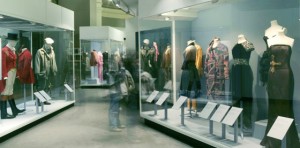
Fashion Exhibit
The museum map became somewhat useless and rather bothersome as I wandered through the labyrinth of art. Branching off of the main sculpture room—which included work from a favorite sculptor of mine, Rodin—were displays of art from China, the Islamic Middle East, Japan, Korea, South Asia, and South-East Asia. Another room I thoroughly enjoyed was a room presenting fashions from Italy, the United States, Japan, England, and France. The clothing dated from the eighteenth century through today. I only explored parts of the first floor and I still had five more levels!
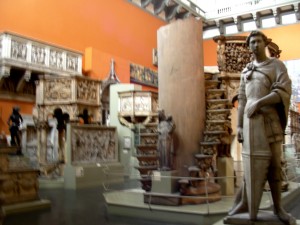
Plaster-casted Sculpture Exhibit (personal photo)
Throughout the remainder of my museum tour, I discovered collections of photography, mini architecture models, prints, drawings, paintings, tapestries, sacred silver and gold, and stained glass. There were also two massive rooms of plaster-casted architecture and sculptures dating from the eighteenth century, when plaster-casting famous works was popular for museum displays. Numerous rooms displayed eclectic exhibits of Medieval and Renaissance European art from the fourth to seventeenth century. When I finally stumbled into a dark hidden room of priceless jewelry dating back from 1500 BC, I was irrevocably astounded. I was lost in the Victoria and Albert museum but when discovering all these sorts of extraordinary pieces of art, who didn’t want to be?

Stained-glass Exhibit (personal photo)
On the whole, the museum’s collection was incredible (if that’s not obvious already). I was completely taken aback by the wide array of art displayed, as well as the priceless items included—countless pieces of silver and jewelry, as well as Leonardo da Vinci’s notebooks and Raphael’s paintings (coming soon). However, the organization of the museum is a contentious topic. The pieces of art come from all over the globe and date back to 1500 BC. Also, obviously, the museum includes almost every type of art. To mitigate this challenge of organizing the art, the museum’s ironically set-up like a maze. The different rooms intertwine and lead you through every floor, and each room is included in the art display. For example, doorways to Renaissance Europe boast beautiful marble columns, tiled floors mimic mosaics on display, monolithic architectural structures make Italian plaster-casted sculptures seem authentic, and aged brick walls and cobblestone floors bring life to the medieval ironwork.

Large-scale Medieval and Renaissance Architecture (personal photo)
From what I could gather, it seems as though the Victoria and Albert Museum is a massive collection of treasures donated by organizations and wealthy individuals. For one, the galleries of donated art pieces ostentatiously display the donor’s name on the wall. Overall, the V&A Museum is a display of wealth—both of England’s monetary wealth and of its wealth of knowledge in the arts. The museum has put on display priceless pieces of art from around the world. The English are subtly, but really quite clearly, boasting. Typical.

One Exhibit’s Entranceway (personal photo)
Tags: 2010 Mary · Museums
September 24th, 2009 · 1 Comment
Firstly, I realize that blogs have become old hat and that many (if not all of you) no longer read them. However, this has been sitting in my Gmail draft box for a dreadfully long time and if only out of annoyance for the Draft(1) icon, I am going to post it. I took to comparing the two last museums I went to. Are they comparable? Maybe not, but I thought they were trying to impart the same message to the viewer, which makes them comparable in my book.
What was it they were trying to show? I think as all museums do, they were trying to capture as much history as possible. But what is different about these two museums is the breathe. In a way it seems they tried to find the essence of beauty, and they tried to find it in many forms. But more importantly, they were both museums dedicated to the lives of those people who sought out that beauty and tried to make it accessible to us all.
Everyone seemed to have gotten hung up on the fashion section, and maybe it’s because I’m a guy who doesn’t really care for wedding dresses, but I didn’t think it was that offensive. The wedding dress is a big deal in English culture, and I imagine for Victoria and Albert it was a big deal too. Queen Victoria became severely depressed after her husband died, marriage was important in those days (a confusing thought in our modern society). But what gets me, is there were so many other fashion exhibits to look at; so many stranger ones. Namely the future fashion stuff, which I pray is not the future of fashion. I particularly liked the stuff of The Porter Gallery though. I really like when artists play with the concepts of what art is. I’m not some high brow art snob but if I’m going to stare at something for ten minutes, I’d like it to challenge my perception, make me think, make me question. Telling-tales did just that. They also have a really good website, which i provided a hyperlink above to. I also really liked the Leighton Room with the paintings and sketches of gardens. How wonderful the English landscape is!
When you talk about the John Soane’s Museum, you must of course first talk about the building itself, for it is as much an item on display as any book or statue. The museum is mostly top-lit, with a similar feeling as another building he designed: the Bank of England. (the Bank of England isn’t worth going to just for the architecture) Other than that, however, the place feels like a labyrinth. There are folding panels, mirrors and strangely placed doors. It is also as eclectically put together as the objects it holds. You go from Roman to Gothic with a step through a doorway and then right back into neo-classical with another. The body of work itself is quite extraordinary. The thing that kept running through my head was that each of these pieces had been sought after, hand selected and cherished. The building was Soane’s soul materialized; he sunk every ounce of his being into collecting and creating. I wonder if with the same resources he had, I would have followed the same path. What dedication he had. And yet I felt almost saddened: the place was absolutely cluttered at some points, and I couldn’t help but feel like he was attempting to fill a void in his life with statues and paintings. When I asked a clerk about John Soane’s personal life I found it to be, indeed, quite depressing. John Soane died a widower and estranged from his only surviving son. So at the end of both the museums we are left with the why. Why did each of these two museums begin to tell a narrative, and why are they the way they are now? For Victoria and Albert, I think they were trying to bring beauty to the masses. This seems to go along with other projects they did including welfare programs and The Great Exhibition. On the other hand, I look at Soane’s collection, and I see loneliness. With his death he handed over everything he had ever worked to collect, almost as an attempt for people to remember him.
Tags: Andrew R · Museums
September 15th, 2009 · 1 Comment
I believe that this is a very important question that we must ask ourselves in order to understand museums and London in general. England is one (or maybe the only one, I am still trying to find out) of the countries in the world that has so many big museums which you can enter for free.
Apparently, museums in London used to be private, but in December 2001, the 15 main ones, such as the British, the Imperial War, the Tate Modern, were made public by Tony Blair’s administration. Many supporters of ‘New Labour’ considered this policy to be one of the major achievements of the party’s agenda. The government at the time was seeking to increase museum audience across the multicultural spectrum. They thought that by making the museums free of charge, they would receive not only a larger audience, but a more diverse one. Why museums? As I mentioned in an earlier post, museums have proven to articulate the ideology of the state and work as institutions that reclaim the national identity, much needed to rule a country.
After some time, research showed that, while making the museums public had increased tourism, they did not attract new audiences, but rather more frequent visits by the same crowd as before (mostly white and upper middle class art lovers).
This makes me wonder why there are so many people in London who might have never attended any of these museums and why not? They’re free! But giving further thought to the matter, I realized that the museum is not going to receive more Africa-descended people by exhibiting African masks. The same way Latin American people in London are probably not going to go to the British Museum’s exhibition of Moctezuma. The Victoria&Albert Museum’s fashion exhibit attracts young designers, but that is probably the most “exotic” audience they have.
What is access to culture then? How do we define it? It is certainly not only a matter of financial access, as we can see. I think that, again, it has to do with how people are located in the structure, and how much cultural capital they have. Once more, it might also be strongly related to being able to afford the time to visit a museum.
Tags: Azul
September 14th, 2009 · 2 Comments
I visited all of the required museums while in London: The National Gallery, The British Museum, The Sir John Salone, the Winston Churchill and Cabinet War Rooms, and the Victoria & Albert. I have not discussed all of these museums in detail on the blog yet, but I want to solely dedicate this blog to the Victoria & Albert Museum. From the moment I walked into the V&A I realized that there was something different, something that I would not get bored with (which is something I couldn’t say about all of the other museums I visited).
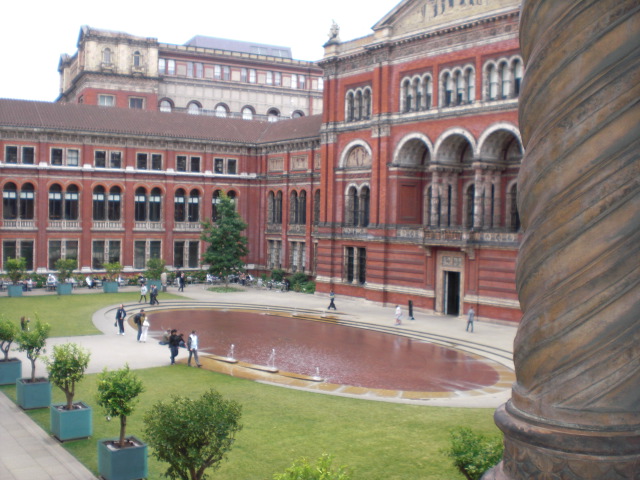
Upon my first visit to the V&A I took the Circle line, which has an underground tunnel that leads directly to the museum entrance at the sculptures section. An entire room full of Roman structured sculptures that led into the Fashion exhibit. Now I would not consider myself a fashionista by any means, however I was completely taken aback. I wandered through this exhibit for almost an hour. The transformation of clothing through the ages, the detail required to make a garment, and the creativity to create something previously unseen– these are the things that I was taking in as I appreciated the artistry that went into every item of clothing on display in that exhibit. The aspect that astounded me the most though was the central portion, a place set up specifically to display the work of current fashion students at the Royal College of Art. It is incredible that these students are able to design a collection on paper and then transform it into clothing that can be worn and then displayed in a world-class museum.
Once I finally made it through the Fashion Exhibit I discovered that there was a Theater and Performing Arts Exhibit and swiftly went upstairs to try and find it. After an hour of searching and wandering through the other exhibits I finally found the exhibit and realized that I was supposed to be meeting the people I had gone with and so I had turn right around. I had wandered through the Sacred Objects exhibit, Prints of Beautrix Potter, and Rod Iron structures, but had not made it to the one exhibit that I wanted to see.
About two weeks later I finally made it back to the V&A and went straight upstairs through the jewelry exhibit and to the Theater and Performing Arts Exhibit. I had heard that the exhibit was full of costumes, but that was only a small section of the room. When you first walked into the room there was a short video playing about ‘What is a Performance? The video touched on music, dance, and theater however I think performance is so much more than that, and the remainder of the exhibit touched on all of the other things that make up a performance: the planning, the staging, the scenery, the promotion. Nothing was left out. I thought that this exhibit was a really good introduction to theater and performing arts.
I’m very glad that I made the journey back out the V&A because I would have been very disappointed if I had not experienced as many of the exhibits as possible. I think part of the reason I enjoyed the V&A so much was because a lot of the exhibits were not stereotypical ‘art’ exhibits. I felt that the Sacred Objects, the Fashion, the Jewelry and even the Theater and Performing Arts exhibits all offered a variety of things to look at and for me just another perspective of what I would considered ‘art’.
Tags: Amanda
September 14th, 2009 · 1 Comment
From what I heard from other group members, I wasn’t quite sure what to expect about the Victoria and Albert Museum. Being situated right next to the Natural History Museum, I wished I could skip the Victoria and Albert and go straight there. Nonetheless, once I entered the V&A, I knew I would not be disappointed. Sadly, I did not get to see every exhibit, but I saw enough to realize how amazing the V&A is. The one exhibit which I really liked was the medieval section. Despite the fact that the other half of it was closed due to renovations and preparation for an updated exhibit, there was no disappointment to be found with the half that was open.
The Cast Courts was perhaps one of the most amazing exhibits I have seen in a museum in London. Though not the originals, the casts in this exhibit are truly marvelous. Trajan’s Column stunned me once I entered the room. Its massive size and detailed inscription spoke volumes about the glory and power that was once the Roman Empire. I had the same feelings of glory and power when I saw the cast of Perseus with the severed head of Medusa. Though nowhere near in size to Trajan’s Column, the cast still gave off an aura of greatness. These feelings were not just with Roman casts. The altarpiece of the annunciation and passion of Christ was spectacular. Its intricate detail and beauty was beyond comparison; it was my favorite altarpiece out of all of them in the V&A. Almost rivaling Trajan’s Column was the Portico de la Gloria. Though in Spain, this cast was simply beautiful. Built to honor God, the structure is also a monument to what Man is capable of creating.
One thing I think some people had a problem with the V&A was that there was just a bunch of differing exhibits together in the same museum; you could go from Medieval Europe to Japan fairly quickly. The question bound to come up is “what makes this British?” I don’t have an answer to this but I can say that perhaps there is nothing truly British about the museum expect for the name. It is possible that the museum wants nothing more than to be a place to learn about other cultures. The British have a long history of colonialism and imperialism; this has inevitably led to the meeting of other cultures. Perhaps now instead of colonizing, the British have decided they want to learn about other cultures through a museum.
—
I think my favorite museum thus far was the Cabinet War Rooms. I love anything related to World War Two so the War Rooms was something right up my alley. The entire thing was highly informative and very interesting. Walking down the narrow corridors just gives you the feeling of being alive in the early 1940s. The small quarters made me realize how difficult it must have been to live and work in the War Rooms. Coupled with the fear of invasion and the reminders of a possible chemical attack (there were a number of gas masks around), to have been alive during this period and to have worked in the War Rooms is something truly remarkable. The British take great pride in standing up to the Nazi war machine and so the Cabinet War Rooms is a place where you can feel that sense of courage and pride in the face of a brutal enemy.
Tags: Andrew F
September 6th, 2009 · 1 Comment
No museum has affected me as viscerally as The Victoria and Albert Museum in South Kensington. Immediately upon entering the museum I was struck by the sight of life-sized Rodin sculptures of the human body that were raised above eye level, which created, for me, a sense of the insignificance of the appreciator, and likewise, the importance of art over all things. These sculptures were grotesque; Rodin used a technique that rendered them black and raw-looking, as if they had once been alive and thrown into a fire, then the charred remains removed and put on display. Though they were shocking and somewhat disturbing, Rodin’s pieces elicited in me a very emotional response, one that cut to the core of my perceptions of the self and of humanity, and one that I can neither explain nor recreate for the reader.
I also really enjoyed seeing several sculptures by Alfred Stevens, including a copy of the original “Truth and Falsehood” which is a part of The Wellington Memorial which we saw at St. Paul’s Cathedral several days ago.
The fashion and jewelry exhibits at the Victoria Albert were equally as touching, but for different reasons. Coming from a background in feminism, I was disappointed in those women who conformed to societal ideals of beauty – women who cinched their waists and bustled their butts, weighing themselves down with heavy jewelry, changing and shifting and molding themselves to ‘fit,’ quite literally, into the beauty myth. One display featuring a bustle and the wooden innards of a hoopskirt were reminiscent of a cage. And would it really be so far from the truth if it were?
Another exhibit which really hit me was photography. A great little exhibit, though I do wish it were larger. I thought that all of the works were quite good, though I connected on a deeper level with just two prints. The first piece was strikingly different. The artist worked with the principles of light and photography and used the sun to burn a simple design into the photo paper. I didn’t quite understand the process by which the piece was created but that’s the beauty of art, isn’t it? You don’t always have to understand it, or at least understand it as the artist does.
One piece that I definitely took a bit of “viewer’s license” to form my own interpretation was a photograph of a beautiful black model in a traditional Georgian dress and wig – both stark white. In her delicate hand she held a large diamond, perfectly cut and gleaming. Her head tilted towards the diamond in her hand, yet her eyes remained fixed intently on the camera. I thought that this piece, out of all the pieces of artwork I have seen at any exhibit thus far, had the most to say. It powerfully conveyed, by capturing just a single moment in time, hundreds of years of British imperialism and the pain it caused the imperialized. The Africans and West Indians were brought to perhaps not-so-‘Great’ Britain and taught that being ripped from their homelands like so many weeds was a privilege. They drowned the enslaved in western culture, which is represented by the model wearing the white (this was surely no mistake) Georgian garb, and meanwhile robbed their homelands of natural resources – such as diamonds and gold – for their own profit.
“Has imperialism, has slavery, really ended?” one must ask him or herself when one considers that there are still related issues in today’s society. The answer should become glaringly apparent when one considers Westerners’ continued thirst for diamonds. Though our presence in the diamond mines of Africa, in places like Sierra Leone, The Democratic Republic of Congo and Angola, may not be physical, our socially-sculpted ideologies surrounding the institution of marriage perpetuates these issues, and exacerbates the problems surrounding blood diamonds. So, for all you ladies out there: next time you stare doe-eyed into a Zales’ display window and exclaim in “I can’t wait to get married!” think twice about what societal forces and social constructions may be at work when you consider the “necessity” of an engagement ring. And the next time you look at a piece of art, everyone, look a little deeper and listen a little closer to what the piece may be trying to say.

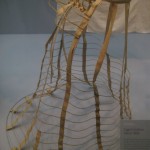
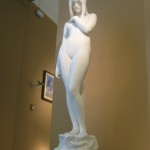



Tags: Anya · Museums
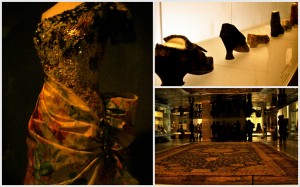
So maybe my culture is not represented here, but as I roamed the Victoria and Albert Museum I realized that some of my interests definitely are. I am a person who highly values artistic performances, self expression through the arts is really important to me, and the Victoria and Albert Museum does a fantastic job at incorporating multiple artistic forms into one beautifully organized building.
Some of the artistic presentations take the form, but are not limited to: sculpting, painting, photography, fashion, design, carpentry and even poetry. I started by observing the sculpture display, made my way through the Japanese and Chinese exhibits of preserved objects, then slowly encountered an interesting section on “Islamic Middle East.” At the “Islamic Middle East” section I was specifically intrigued by a huge carpet laid flat across the floor inside a glass box, it slightly lit for ten minutes on the hour and on he half hour to prevent the colors from fading. This carpet goes by the name of “The Ardabil Carpet” (dated to 1539-40) and is one of the “finest” and “largest” islamic carpets in existence. I was most amazed by its size and the way it was displayed. The chosen form of display majestically asserted its importance. You can tell this carpet took an extensive amount of work to create and so I sat in front of it, and took a moment of my time to appreciate its intricacy.
With infinite excitement, I then proceeded to the fashion exhibit! I had heard about it from one of my peers who visited the museum a few days ago and I was really excited for what was in store. I’ve lived in NYC for about eight years of my life, so I can’t help but to be interested in fashion (as weird as that may sound). The dresses in this exhibit were like paintings, pieces of art work designed with precision, colored with care and story tellers of their own history. As I roamed, I stopped at a window displaying the evolution of the shoe. Suddenly, I thought back on something professor Qualls said at one of our most recent class discussions: “Progress can be good, but for who?” I was observing the evolution of the shoe, the progress of this everyday item, this extremely useful item that some of us filled our suitcases with. But who’s shoe is evolving? Who wore these fancy shoes, who’s progress was this? What about the people without shoes? I asked myself. From that moment on I knew my own questions would prevent me from enjoying the rest of this exhibit so I left this part of the museum. I stopped by the fairy tale furniture exhibit as well as the heaven and hell, quickly perused the small pathways until I realized that it was time for me to gather with the rest of my peers.
I entered the garden on my way out, where I was mesmerized by the peace I suddenly found there, although short-lasting it was very filling. As I reflected on the things I saw at this museum I realized that, slowly, I am finding the “me” in the streets of London. At the museum I found many of my interests and soon, as we do more learning and exploring I am confident that I will find more parts of who I am in the parts of London we have yet to explore.
Tags: Flow · Uncategorized
August 31st, 2009 · 1 Comment
Imagine being in a place where all of your passions interconnect, where your heart races, you forget to breathe, your interest peaks. I have to remind myself to breathe today upon entering The Victoria and Albert Museum directly from stepping off the tube station into the museum. Deep breaths, I say to myself when I see Louis Richard Garbe’s piece, Primavera. Deep breaths I tell myself when I see the dresses by Catherine Walker worn by Princess Diana. Deep breaths when I stumble upon Joan Rhodes’s theatrical costumes, Reg Wilson’s performance photographs, sight of jewelry worn throughout centuries, breath taking carpets and other Islamic crafts. Inspiration surrounds me everywhere.
“Sculpture is a three-dimensional object with a message…”
Bob Brendle
After examining the sculptures showed at The Victoria and Albert Museum, I felt the messages sculptures were illuminating. A child and a mother, the look they share, the connection and love that exists between them. A cupid slyly planning his next attack, by preparing a bow and arrow to shoot at a King. Two soldiers fighting, the anger and determination in their stony eyes. Moving on to Islamic carpets, I am reminded of my own culture, of beautifully woven rugs and elaborately decorated vases. Not having a map at hand, I began walking through the museum, stumbling upon the silver lined plates and crafts of Paul de Lamerie and the portion of the museum which holds theatre exhibitions. Ranging from costumes worn by Joan Rhodes to the construction of the stage and backstage look at the performances in 18th Century, I was pleasantly surprised. Although the museum provided satisfaction to all of my senses, I was on the quest to finding two of my upmost passions, photography and jewelry. As I finally stepped through the doors of jewelry exhibit, I was blinded by diamonds, gold, silver, crowns, pendents. I thought “This is what heaven must look like” (at least in my world). Behind glass windows, jewels worn in 1500’s lined against the walls ranged to the present trends in jewelry. Inspiration surrounding me everywhere, I headed towards the photography section. As I entered, I was overpowered by Charles de Temple, E.R. Nele, Roger Moris and many more. The museum began acquiring pieces in 1852 and now I was in the presence of classic as well as contemporary works. One piece that particularly caught my attention was of a “Shell-shocked Soldier, Hue” by Don McCullin in 1968 taken during the Vietnam War. The simplicity yet so much emotion behind the piece and the soldier’s eyes is indescribable. My passion has ignited. Although I have always captured my surroundings and emotions through a camera lens, seeing the photography exhibit has encouraged me and made me hope that one day I can also show my work. Who knows what holds in the future for me and my photography. But for now I am planning on returning to The Victoria and Albert Museum and exploring other photography exhibitions in London such as Tom Hunter’s “A Journey Back” shown close by on Oxford Street.
I am inspired. 
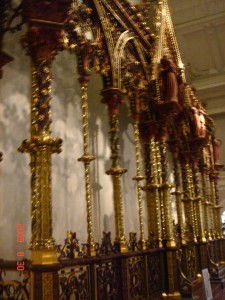
Tags: Jeyla · Museums



















